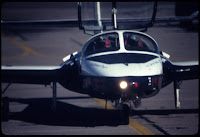 Years ago, the United States Air Force’s primary trainer was the T-37. It was a Cessna built, side-by-side controlled, twin powered, small jet. Its nickname was the “Tweet,” or the “Dog Whistle,” for its irritating, high-pitched sound when the jet was on the ground and idling.
Years ago, the United States Air Force’s primary trainer was the T-37. It was a Cessna built, side-by-side controlled, twin powered, small jet. Its nickname was the “Tweet,” or the “Dog Whistle,” for its irritating, high-pitched sound when the jet was on the ground and idling. Pilots said the plane turned JP-4 jet fuel into noise. Republican Presidential candidate and Arizona Senator John McCain, a former Naval aviator, who flew a different kind of trainer, seemed to engage in a fuel to noise exercise as he traveled to Albuquerque for an Election Day stop.
Pilots said the plane turned JP-4 jet fuel into noise. Republican Presidential candidate and Arizona Senator John McCain, a former Naval aviator, who flew a different kind of trainer, seemed to engage in a fuel to noise exercise as he traveled to Albuquerque for an Election Day stop.McCain considered New Mexico “in play.”
So what’s wrong with this picture?
There is no picture.
McCain was scheduled to visit Albuquerque on Saturday Oct. 25, according to local press reports. I received notification of McCain’s visit to Mesilla, New Mexico, and his airport arrival at El Paso, Texas, but nothing about Albuquerque. I contacted McCain’s national press office, which sent me about 50 e-mails of press event notices, speeches and media releases, over the last 10 days of the campaign.
McCain visited the Duke City, Tuesday, in his final campaign stop before going home to Phoenix, Ariz. Despite all the e-mails of press event notices around the country, I received nothing about my back yard event.
He was in Roswell, Monday for the sixth of seven stops during the day. Monday’s campaign covered 3,700 flight miles, according to McCain, who spoke to reporters for the first time in months, on his airplane, Tuesday.
I first became aware of McCain’s Tuesday trip through an Associated Press story that he would be visiting the city. Local media outlets were putting information out on their websites; I just hadn’t noticed.

Republican operative, Marta Kramer, was New Mexico campaign manager. You’ve met her before, here in postings about how, as the State Republican Party Executive Director, she censored and refused access to media that she considered unfair to her candidates. Read: 2006 Election Returns,
Can We See Laura?
The Good, the Bad and the Ugly; the Mean and the Nasty! But let’s not forget the Weird!
This is Kramer with State Republican Party Chairman Allen Weh at the October 25, State Fairgrounds McCain event.
 The cap Kramer is wearing has the McCain-Palin logo and reads, “270.” The first thing that came to mind was another aircraft reference. When in the air and pilots wish to reference a landmark or point out the location of another aircraft at the nine o’clock position; the phrase is 270 (degrees) relative. In other words, the object is 90 degrees to the left; or a left turn. Of course the second thought was 270 represents the number of Electoral College votes necessary to secure a presidential victory.
The cap Kramer is wearing has the McCain-Palin logo and reads, “270.” The first thing that came to mind was another aircraft reference. When in the air and pilots wish to reference a landmark or point out the location of another aircraft at the nine o’clock position; the phrase is 270 (degrees) relative. In other words, the object is 90 degrees to the left; or a left turn. Of course the second thought was 270 represents the number of Electoral College votes necessary to secure a presidential victory. The early Saturday morning event was attended by, my estimation, as being no greater than 850 people. This is a photomontage of more than 270 degrees of the event site. Click on the picture and see just how many people were present.
The early Saturday morning event was attended by, my estimation, as being no greater than 850 people. This is a photomontage of more than 270 degrees of the event site. Click on the picture and see just how many people were present.Note:
The methodology for assessing and estimating crowds vary. I personally count 100 people and establish a geographic size for them, then use my hands to create a circle to surround the hundred. I use the circle to go across the crowd in blocks counting how many blocks it takes to cover the entire crowd. I then add ten percent for any slop that could be introduced. There is an advantage in being higher than the crowd. Looking across a crowd gives an impression that the crowd is larger. The higher one goes, the better the count gets. That’s why a television shot from a helicopter is better than being on the ground.

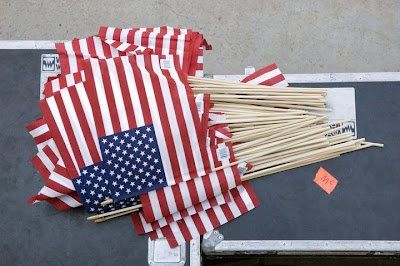 It’s the little things that indicate when a campaign is in trouble. The small turnout was only one such indication. What screamed volumes was that there were about 60, 12 by 18 inch American flags piled on the sound equipment storage boxes directly behind the main press riser. The flags were not distributed to the crowd. Such events rely on meticulous staging and from a campaign standpoint; flags could have added an emotional touch to the message broadcast around the world.
It’s the little things that indicate when a campaign is in trouble. The small turnout was only one such indication. What screamed volumes was that there were about 60, 12 by 18 inch American flags piled on the sound equipment storage boxes directly behind the main press riser. The flags were not distributed to the crowd. Such events rely on meticulous staging and from a campaign standpoint; flags could have added an emotional touch to the message broadcast around the world.Broadcast around the world? There were at least three International television crews present:
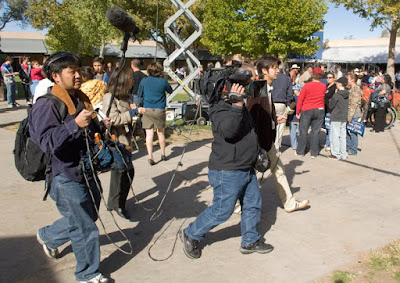 a Tokyo Broadcasting news crew,
a Tokyo Broadcasting news crew,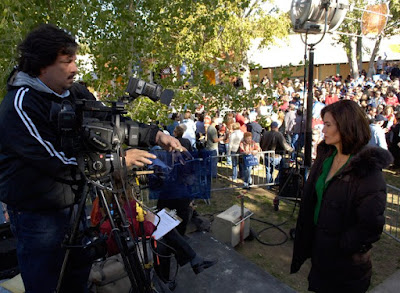 a Brazilian news crew and
a Brazilian news crew and a Mexican Television Network News photojournalist, seen here with the McCain campaign’s lighting specialist.
a Mexican Television Network News photojournalist, seen here with the McCain campaign’s lighting specialist.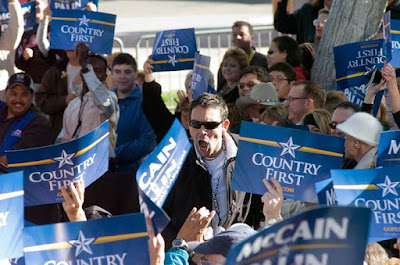 Desperation seemed apparent by the size of the small crowd. They were enthusiastic, but just not very many of them and they had to be pumped up by a man running across the stage and yelling.
Desperation seemed apparent by the size of the small crowd. They were enthusiastic, but just not very many of them and they had to be pumped up by a man running across the stage and yelling. These two members of the band "Missing Stateside" of Albuquerque, are Gov. Palin's cousins. They played for the small crowd before the formal event started.
These two members of the band "Missing Stateside" of Albuquerque, are Gov. Palin's cousins. They played for the small crowd before the formal event started.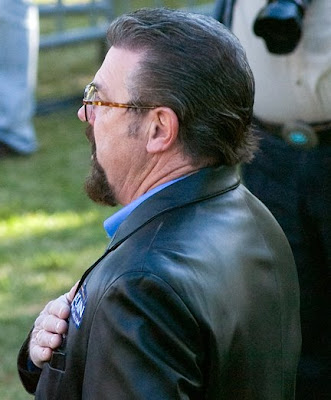 It was further reflected in the gung-ho attitude displayed by this decorated veteran, who is incapable of restraining himself in the presence of an American flag. He shouts out to the crowd, asking that they join him in reciting the pledge of allegiance, before the person scheduled on the program can be introduced. This man did the same thing during the Memorial Day event attended by McCain. This person stands tall, is unapologetic for his zeal and causes an awkward moment for organizers.
It was further reflected in the gung-ho attitude displayed by this decorated veteran, who is incapable of restraining himself in the presence of an American flag. He shouts out to the crowd, asking that they join him in reciting the pledge of allegiance, before the person scheduled on the program can be introduced. This man did the same thing during the Memorial Day event attended by McCain. This person stands tall, is unapologetic for his zeal and causes an awkward moment for organizers.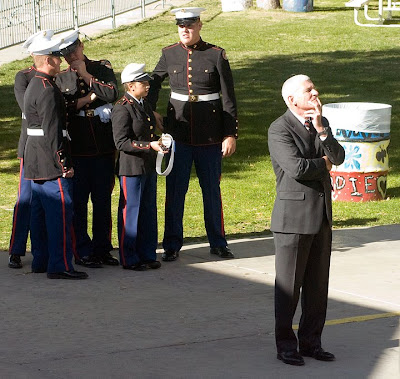 Weh stood stoically at the back of the event. A high school Marine ROTC Honor Guard stood nearby.
Weh stood stoically at the back of the event. A high school Marine ROTC Honor Guard stood nearby.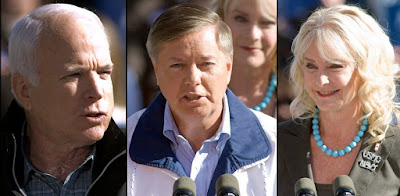 When Cindy McCain, right, the mother of a Marine deployed in Iraq and another son at the Naval Academy, prepared to introduce Sen. Lindsey Graham, center, she started by pointing out the Marines, not indicating they were students, and thanked them for their service. Graham introduced McCain, left.
When Cindy McCain, right, the mother of a Marine deployed in Iraq and another son at the Naval Academy, prepared to introduce Sen. Lindsey Graham, center, she started by pointing out the Marines, not indicating they were students, and thanked them for their service. Graham introduced McCain, left.
The reason I didn’t get photographs of McCain’s Election Day stop is not because I wasn’t trying to cover the event, but due to efforts by the local campaign to exclude the coverage. I wasn’t the only local outlet not to receive notification.
In my last post, I wrote about going to vote late in the day hoping to savor the entire campaign season.
When I learned McCain was supposed to be in town, I called his national press office and asked what was happening. The man who answered went through the standard routine; asking name and affiliation. After telling him who I was and that I was a freelancer who had covered all of the Senator’s visits to Albuquerque, he told me he had no information on the whereabouts of his candidate. When I pressed him, he said any pertinent information would come from the local campaign headquarters. I asked his name and there were several seconds of silence. I asked him a second time for his name and he hung up.
Little did I know McCain’s airplane had wheels up 15 minutes earlier and should have been crossing the State Line about then.
 These are five views of McCain when he appeared in Albuquerque at: the May 26, Memorial Day ceremony at New Mexico Veterans' Memorial Park, his getting off the "Straight Talk Express" airplane three times, on July 14, Sept. 6, and Oct. 2, then at the Oct. 25, Expo New Mexico’s Spanish Village. I did not photograph McCain in Mesilla or Roswell; I also missed Alaskan Gov. Sarah Palin three weeks ago in Roswell.
These are five views of McCain when he appeared in Albuquerque at: the May 26, Memorial Day ceremony at New Mexico Veterans' Memorial Park, his getting off the "Straight Talk Express" airplane three times, on July 14, Sept. 6, and Oct. 2, then at the Oct. 25, Expo New Mexico’s Spanish Village. I did not photograph McCain in Mesilla or Roswell; I also missed Alaskan Gov. Sarah Palin three weeks ago in Roswell.
I started to write the following as a separate posting about McCain’s short Oct. 2 visit to the University of New Mexico. However, I was hesitant to publish out of a real fear that I might not be allowed access to any future events. How prophetic? I had access to one event and yet not another.
Every campaign is different, every event unique.
McCain had a very laid-back campaign style initially. He was unconcerned with the U.S. Secret Service until he wrapped up the statistical count of primary delegates making him the presumptive nominee and nearly had Congress force protection on him.
He would talk to the press forever, inviting the local pool on his “Straight Talk Express” motor home and talked on the airplane with the national traveling press while in flight. He’s referred to members of the media on more than one occasion as “jerks.”
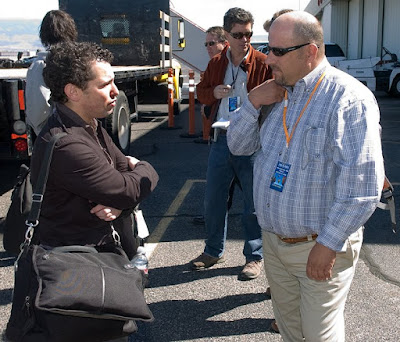 This is the Boston Globe’s Washington Bureau Political Reporter Sasha Issenberg, left chatting with St. Cyr. Issenberg joined the McCain campaign in Albuquerque, traveling to St. Louis for the Friday evening, Oct. 4, second Presidential debate at Washington University.
This is the Boston Globe’s Washington Bureau Political Reporter Sasha Issenberg, left chatting with St. Cyr. Issenberg joined the McCain campaign in Albuquerque, traveling to St. Louis for the Friday evening, Oct. 4, second Presidential debate at Washington University.Issenberg, who had traveled off and on during the campaign, said relations with the press had drastically changed from the earlier, more relaxed primary days, until the post convention where hardly anything was said to the media. Part of that change was due to the Vice Presidential nominee, Palin, and the campaign keeping her from the press.
McCain was also asked a tough question, July 9, about a Senate vote on requiring insurance companies that pay for Viagra, but do not pay for women’s birth control, to pay for both. There was a lot of discussion about how badly McCain handled the question. I described it to fellow journalist as the best “wrong answer.”
McCain seemed to be searching his mind for several things: trying to remember the legislation, if he had any recollection about the issues, if he remembered having any discussion about the issue before, and he was trying to think if he had an answer. His conclusion seemed to be, none of the above.
McCain was hounded by the video and ridiculed for not having an immediate answer. I saw it differently, I saw a man thinking, searching, and pondering a question that was not superficial. I saw what I want in a President, what most Americans should want in their President, a thought. It is clear from the many varied reactions of people that there was no simple answer to the question. It was so wide ranging that I heard people think it was only a question of a philosophical male-female medical and prescription policy hypocrisy and even to a question of whether McCain took Viagra.
His campaign staff seemed to think the video made him look bad and unprepared; open press sessions disappeared.
 This is McCain ’08’s New Mexico Campaign Manager Kramer, center with the scarf, briefing selected Republican greeters for McCain’s arrival at the Sunport, Friday Oct. 3. From the left: Rowena Baca, front, Barbara Romero, Geraldine Sanchez, Abbie Woodward, seated, Kenneth Holston, white cap, Neil James, seated with the blue shirt, Jim “Cyber” Grant, purple shirt and black cap and Alfred Perez, right, in the suit.
This is McCain ’08’s New Mexico Campaign Manager Kramer, center with the scarf, briefing selected Republican greeters for McCain’s arrival at the Sunport, Friday Oct. 3. From the left: Rowena Baca, front, Barbara Romero, Geraldine Sanchez, Abbie Woodward, seated, Kenneth Holston, white cap, Neil James, seated with the blue shirt, Jim “Cyber” Grant, purple shirt and black cap and Alfred Perez, right, in the suit.Behind Kramer, to the left is Mike Garofalo of KOAT and to the right, Daniel Boyd in the brown shirt, of the Albuquerque Journal, part of the local press pool. The man in the black suit with the beard is Jim Spiri, a McCain volunteer who photographs the local campaign.
Kramer told the greeters that they could gain entry to McCain’s speech by checking in at the press desk at the University of New Mexico Student Union Ballroom entrance.
The event schedule was tight. It was so tight that theoretically one could not cover both the airport landing and the UNM event. The press gear was supposed to be in the room at 11:30 am, an hour and five minutes before the airplane was scheduled to arrive.
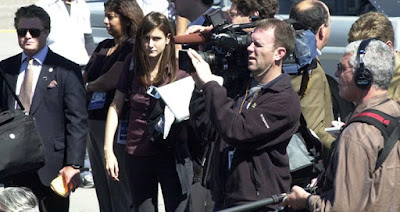 Experience says, you can get both events covered, even if you’re not in the local press pool. McCain’s Press Advance Matthew Cohen, seen far left monitoring the national press, and J.P. Hyso of KOAT TV with the camera on his shoulder, had told me he would assure my entry and if there was a problem, to call him on his cellular phone.
Experience says, you can get both events covered, even if you’re not in the local press pool. McCain’s Press Advance Matthew Cohen, seen far left monitoring the national press, and J.P. Hyso of KOAT TV with the camera on his shoulder, had told me he would assure my entry and if there was a problem, to call him on his cellular phone.As McCain’s motorcade traveled towards UNM, I also made my way there.
When I arrived at the press sign-in table, the Uniformed Secret Service detail was taking down their magnetometer. I asked if I could speak to the McCain staff manning the table, thinking they must be close by. The officer explained that the campaign had shut down further entry.
What I didn’t immediately realize was, entry to the event ceased and the volunteer staffers had abandoned their posts. The officer said he wouldn’t help find a press desk staffer, but said I could call them. I stepped back, on my own, behind a cloth expandable barrier, the kind used at fast food restaurants, banks and airports to control crowds.
Greeters, Neil James and his sister Abbie Woodward, arrived and between us, we pooled the phone numbers of McCain’s local Campaign Manager Kramer, Press Advance Cohen, and Site Media contact Mark Wagar. All cellular phone calls went unanswered.
I still had a backup plan or two, of people I knew who were at the event and capable of making contact with Cohen.
 While waiting for a call back, I raised my camera and photographed three USSS uniformed officers, above. The officer in the center raised his hand just above his belt and waved it back and forth three times. I took it to mean, not to take pictures. I lowered my camera.
While waiting for a call back, I raised my camera and photographed three USSS uniformed officers, above. The officer in the center raised his hand just above his belt and waved it back and forth three times. I took it to mean, not to take pictures. I lowered my camera.The officer approached me and said, “Don’t take any pictures.”
“This is America; First Amendment and all,” I asked?
“Oh, I’m not telling you that you can’t take pictures,” he said. “Just don’t take my picture.”
As a journalist, a member of the fourth estate, a watchdog on government, I’m required to confront such a statement, which is a form of censorship.
“You’re a uniformed agent of the United States,” I said. “You may not ask me that.”
“You can take pictures,” he repeated. “Just don’t take my picture! OK?” The officer used the verbal demand utilized to intimidate the unknowing citizen.
I told him if he didn’t want his picture taken, then step out of the line of the camera’s lens.
He went outside and brought back three University of New Mexico Police Department Officers. A Lieutenant turned around before entering the building.
 Officer Christopher Crespin, left and Sergeant Jeremy Parrish approached.
Officer Christopher Crespin, left and Sergeant Jeremy Parrish approached.I recognized Crespin from him throwing me off the University of New Mexico Hospital grounds, last year, for taking a photograph of the new Bill and Barbara Richardson wing shot for Capitol Report New Mexico.
“I know who you are,” Crespin said. “You have to leave.”
I know an arrest when I see one, and I wasn’t going to resist.
“…Why are you removing me?” I asked.
“This is their security, they’re, uh they’re Secret Service,” Crespin said. “They don’t want you in there. I don’t know why, but you have to go outside. Thank you.”
He and Parrish wouldn’t engage in much discussion and certainly weren’t going to admit that they had no idea why the Secret Service officer wanted me removed.
Listening to only one side of a story, even if it is from another law enforcement officer, is an improper police procedure.
I wonder why an officer would be so willing to risk becoming part of a violation of civil rights complaint, by not even listening to the facts.
The Secret Service is not the campaign, but they often adopt attitudes and enforce their wishes.
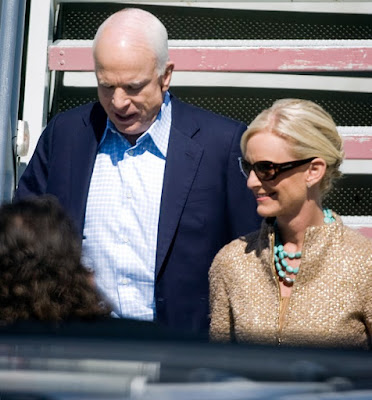 Ultimately, I could not cover both McCain and his wife Cindy’s arrival and his speech.
Ultimately, I could not cover both McCain and his wife Cindy’s arrival and his speech.
…And Sometimes the Bear Gets You.
It seemed that the Oct. 3, McCain event was hastily put together, as the announcement arrived on Sunday for the Monday mid-day events. McCain had spent the weekend at home in Arizona. The campaign was headed to the Tuesday Presidential debate, and Albuquerque must have just been on the way.
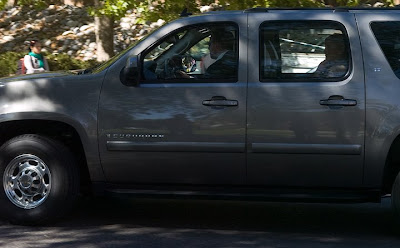 The other telling point of how hasty this stop was planned and put together was the absence of a “Straight Talk Express” bus to drive McCain and his wife to the campus. They ferried about in an SUV.
The other telling point of how hasty this stop was planned and put together was the absence of a “Straight Talk Express” bus to drive McCain and his wife to the campus. They ferried about in an SUV. The local Secret Service rented a car with a Mexican license plate from Chihuahua. It qualifies as a “What’s wrong with this picture?” photograph.
The local Secret Service rented a car with a Mexican license plate from Chihuahua. It qualifies as a “What’s wrong with this picture?” photograph.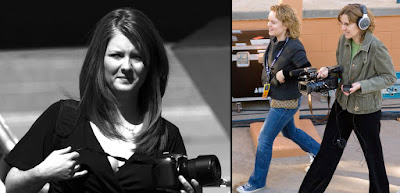 The Party mobilized staff from various other campaigns to augment ground personnel for the top candidate. Darren White’s Campaign Manager Sarah Lister, left, and NM GOP Communications Director Shira Rawlinson, center, seen here escorting Santa Fe New Mexican’s Kate Nash, right, helped national campaign staffers.
The Party mobilized staff from various other campaigns to augment ground personnel for the top candidate. Darren White’s Campaign Manager Sarah Lister, left, and NM GOP Communications Director Shira Rawlinson, center, seen here escorting Santa Fe New Mexican’s Kate Nash, right, helped national campaign staffers. This is McCain’s Communication Director Brooke Buchanan. She is the enforcer of press rules.
This is McCain’s Communication Director Brooke Buchanan. She is the enforcer of press rules.
Analysis
The McCain campaign seemed to start slipping as outside events and internal problems started to overtake the organization.
Hurricane Gustav striking the Gulf coast the first day of the Republican National Convention proved problematic and fortuitous at the same time. The GOP was cognizant of the abysmal emergency response to Hurricane Katrina and the massive devastation to the New Orleans area two years ago. Party leaders did not want to appear like they were holding a celebration as a large area of the country was under the threat of a natural disaster. The fortuitous part of the storm’s threat was that in abbreviating the opening ceremonies, President George W. Bush canceled his scheduled appearance before the convention.
McCain’s choice of running mate, Palin, was at first a big draw, supercharging the conservative base, which was not totally enamored with him.
 McCain and Palin withdrew from having open contact with the press and tighter controls were imposed on access. Pictures of Palin were considered fine and even encouraged, but talking to her was forbidden and harshly dealt with.
McCain and Palin withdrew from having open contact with the press and tighter controls were imposed on access. Pictures of Palin were considered fine and even encouraged, but talking to her was forbidden and harshly dealt with.Palin’s luster wore off quickly as people started to learn more about her. She did a couple of national network television interviews and was perceived to have not performed well.
The campaign ran into several self-created problems.
They announced the withdrawal of all campaign workers and pulled TV ads from Michigan. Even within the Republican Party, there were those who thought the announcement was a blunder. Some thought that it should have been stated that there was a cut back and even if they left only one staffer, it would not have seemed like a total surrendering of the state. Palin would object to the move and was willing to visit the state herself.
McCain suspended his campaign rather than postponing scheduled stops to go back to Washington to work on the financial crisis. It was another wording problem. Obama supporters pointed out the need for a President to be able to "multi-task."
McCain suggested canceling the first Presidential debate, but eventually showed up.
The financial crisis was tied to the current Republican administration and McCain was not able to successfully distance himself from Bush.
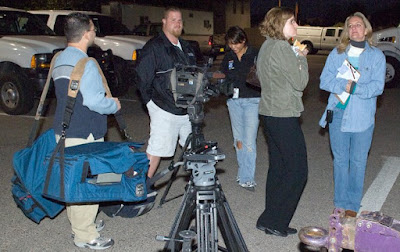 Off and on this year, McCain’s New Mexico Campaign Communications Director Whitney Cheshire, right, vacillated from being hostile before, to being very friendly at the Fairgrounds event, when she greeted members of the media for the Secret Service’s press sweep. She is seen here talking with Santa Fe New Mexican Political Reporter Nash and other journalists.
Off and on this year, McCain’s New Mexico Campaign Communications Director Whitney Cheshire, right, vacillated from being hostile before, to being very friendly at the Fairgrounds event, when she greeted members of the media for the Secret Service’s press sweep. She is seen here talking with Santa Fe New Mexican Political Reporter Nash and other journalists. There was one local volunteer who was extremely helpful, Jim Spiri, who photographed for the campaign.
There was one local volunteer who was extremely helpful, Jim Spiri, who photographed for the campaign.
 KKOB-770 News Radio’s Chief Political Reporter Peter St. Cyr’s take was that, in the waning months, McCain was on a wildly expensive internal junket; flying around the country in a 737 and riding in a luxurious custom motor home, called, the “Straight Talk Express.”
KKOB-770 News Radio’s Chief Political Reporter Peter St. Cyr’s take was that, in the waning months, McCain was on a wildly expensive internal junket; flying around the country in a 737 and riding in a luxurious custom motor home, called, the “Straight Talk Express.”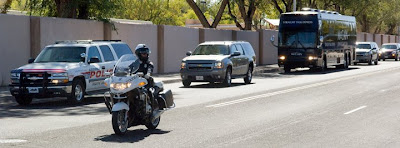 St. Cyr was one of the few reporters able to maintain the ability to get interviews with McCain.
St. Cyr was one of the few reporters able to maintain the ability to get interviews with McCain. He represented the radio medium in the local press pool during several visits and rode “The Straight Talk Express,” July 14, when McCain answered questions with four other journalists. They are seen here headed to the bus and are: Barry Massey of the Associated Press, the McCain press liaison volunteer from St. Petersburg Fla, St. Cyr, Jeff Jones of the Albuquerque Journal, Nash of the Santa Fe New Mexican and blogger Heath Haussamen on New Mexico Politics taking their picture.
He represented the radio medium in the local press pool during several visits and rode “The Straight Talk Express,” July 14, when McCain answered questions with four other journalists. They are seen here headed to the bus and are: Barry Massey of the Associated Press, the McCain press liaison volunteer from St. Petersburg Fla, St. Cyr, Jeff Jones of the Albuquerque Journal, Nash of the Santa Fe New Mexican and blogger Heath Haussamen on New Mexico Politics taking their picture.Mid October, St. Cyr got a five-minute telephone interview.
St. Cyr was in the pool Sept. 7, when Vice Presidential candidate Palin approached him at El Pinto restaurant to chat. He got a half-minute of audio recorded before the campaign press handlers descended upon him, putting a stop to their talking before a tough question could be asked. St. Cyr knew that Palin was in a “no interview” status and didn’t violate the campaign-imposed “rule.” He wasn’t punished and was in the pool again for other visits. The campaign, however, no longer held press conferences or briefings with the media.

My Take
Throughout this campaign cycle and the last, two years ago, Republican operatives in New Mexico have been involved in a struggle to maintain their grip on the leadership of the State GOP. A small group of far right members have a strangle hold on the organization and have shut out the moderate center, and liberal parts of the party. Decisions made by such party leaders to promote their candidates over other Republican contenders during the primary, in violation of the Party’s own rules, and their abandoning support in favor of the chosen few, doomed some candidates from having a fighting chance of winning.
The hard right ideology is not representative of the larger sense within the Republican Party. The leadership continues to engage in self-serving, self-promoting and self-protective actions in the face of charges of corrupt activities.
An oft-repeated question I hear about State Republicans is, how can the 70 plus year Democratic hold, as the majority party, be broken by the Republicans? The answer is simple; Republicans must get more votes. The problem is that, though the hard right wing of the Party is capable of getting their favorite candidates through the primary process, they are incapable of attracting the middle of the electorate. Such philosophically hard candidates even drive off moderate Republicans.
As long as the radical wing of the Party demands lockstep thinking and is unwilling to accept a broader view from similarly-minded, but not always those completely in agreement with them, the Party will not grow their “base” broad enough to prevail at the polls. The selected candidates must have an appeal that reaches the depth of the “conservative base” and yet they must also reach into, not only the moderate Republican ranks, but beyond, to the independents and conservative Democrats who will then make up a majority vote.
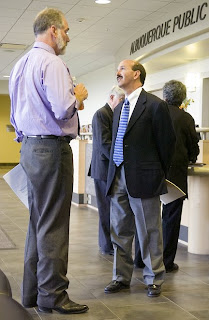 My blogging colleague and client, Ched MacQuigg of "Diogenes’ Six," is a regular critic of Albuquerque Public School’s lack of compliance with ethical standards.
My blogging colleague and client, Ched MacQuigg of "Diogenes’ Six," is a regular critic of Albuquerque Public School’s lack of compliance with ethical standards.MacQuigg, left, seen here with APS Communication Office Director Rigo Chavez, filed a complaint with the State GOP accusing New Mexico Republican Party’s 1st Vice Chairman Jon Barela, of violating a couple of sections of the State rules:
1-4. GENERAL - CONFLICT OF INTEREST - RESTRICTIONS“Jon Barela contested for a vacant seat on the Albuquerque Public Schools Board of Education (a Public Office) against at least three registered Republicans; Kathy Frazier, Mike Gibson, and Arturo Candelaria,” according to MacQuigg. “Jon Barela did not vacate his seat as required by NMRP Rule 1-4-1.”
1-4-1. WHEN A PARTY OFFICER BECOMES A CANDIDATE FOR PUBLIC OFFICE
In the event the State Chairman, or any other State Officer of the Republican State Central Committee, shall file as a candidate for Public Office, and more than one Republican files as a candidate for that office, the State Officer shall immediately vacate the Party Office. In that event, the successor shall be selected in the manner for filling vacancies as in these Rules provided.
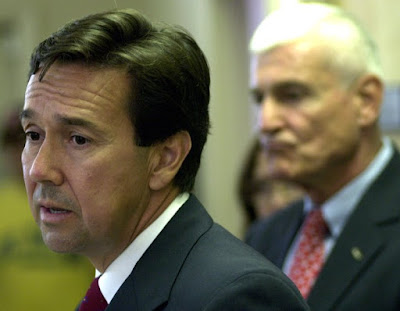 Republican insiders predict Barela, left, is likely to run for the Party Chair as Weh, right, steps down early next year. Barela is also expected to run in the Feb. 3, 2009, APS School Board elections.
Republican insiders predict Barela, left, is likely to run for the Party Chair as Weh, right, steps down early next year. Barela is also expected to run in the Feb. 3, 2009, APS School Board elections.The GOP Rules Chair Lou Melvin scheduled a telephonic rules committee meeting. However, when news of the meeting was made public by another one of my colleagues and client, Joe Monahan, who posted the allegation, Melvin postponed the meeting. Melvin requested a written legal opinion that suspended the proceedings.

It was the attitude, not of the candidate, McCain, but his campaign workers and Party leaders, which created a level of arrogance and over control of media access that is palpable amongst journalists. The attitude does not help the candidate’s reputation for honesty. In other words, when a staffer either: outright lies, withholds information, deceives, misdirects, or plays favorites with journalists, they damage both the candidates and their operatives.
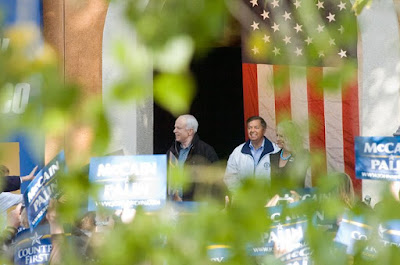 Campaigns, of all parties work hard to control their message and attempt to change it very little. A journalist can follow events for months and find that the original stump speech is basically intact. The media learns the speech to the point that they can recite it verbatim. They hang on every word, hoping for a new line upon which to report.
Campaigns, of all parties work hard to control their message and attempt to change it very little. A journalist can follow events for months and find that the original stump speech is basically intact. The media learns the speech to the point that they can recite it verbatim. They hang on every word, hoping for a new line upon which to report. Photographers seek a new angle or interesting prop that gets introduced to the interminable show.
Photographers seek a new angle or interesting prop that gets introduced to the interminable show.
As the State Republican Party goes into their selection process, they have some credibility issues. One is that the leadership positions are up for election, just months before the Central Committee is elected. This concept is contrary to any sound precept for an “open” organization. Normally, a newly elected body gets to select its own leadership and not have them imposed by an earlier group that might be ousted by the most recent vote.
Combined with the heavy handed leadership, the rejection of the National Party rules as a guide for the State and the use of the “Rule of the Gavel” as the chairman runs meetings as he sees fit, there is no method to challenge that chair or to appeal to the membership to control their meetings.
The State Party will never become strong unless they live up to the ideal expressed in the National Party Preamble.
BE IT RESOLVED, That the Republican Party is the party of the open door.The final aviation metaphor taught to me by my airplane flight instructor to describe a young person plenty of enthusiasm, but no direction to characterize the current Party. “All airspeed, no azimuth. ”
Ours is the party of liberty, the party of equality, of opportunity for all, and favoritism for none.
It is the intent and purpose of these rules to encourage and allow the broadest possible participation of all voters in Republican Party activities at all levels and to assure that the Republican Party is open and accessible to all Americans.
No comments:
Post a Comment